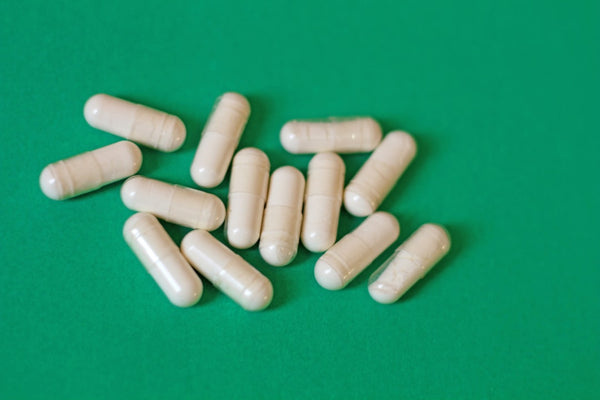How Constipation Can Cause Your Kid's Reflux
share this article
 If your little one frequently complains of tummy aches, nausea, burping, or seems to have a low appetite, they may be dealing with reflux, constipation, or both.
If your little one frequently complains of tummy aches, nausea, burping, or seems to have a low appetite, they may be dealing with reflux, constipation, or both.
These issues are common on their own, but many families don’t realize how often they’re connected - around 60% of kids with constipation also experience reflux symptoms (1).
Understanding how constipation can contribute to reflux is a key step in helping your kiddo feel better. Let’s break down the connection, what symptoms to look out for, and how to manage both issues by supporting healthy digestion.
How Constipation Can Cause Reflux
Reflux, or gastroesophageal reflux disease (GERD), happens when acid from the stomach flows backward into the esophagus. This backflow can be uncomfortable or even painful, especially after meals.
When your kiddo is constipated, their intestines can become full and create upward pressure against the stomach. This increased pressure in the belly slows down how quickly the stomach empties (1). When food lingers in the stomach longer than it should, it raises the risk of acid reflux.
However, when constipation is treated and digestion is more regular, reflux often improves as well (2).
Symptoms to Watch For
Reflux symptoms can look different depending on your kid’s age and how severe their reflux is. Many kids have trouble articulating reflux symptoms, so it helps to watch for physical signs like:
-
Frequent spit-up or vomiting
-
Frequent burping
-
Nausea after meals
-
Chronic cough, especially at night
-
Hoarseness or sore throat
-
Trouble swallowing or feeling like food is stuck
-
Complaints of tummy aches or feeling “full”
-
Poor appetite or refusal to eat
-
Irritability or disrupted sleep
If your kiddo is showing some of these reflux signs, and you’ve also noticed changes in their poop (going less often, having harder stools, or straining) constipation may be part of the problem.
Managing Constipation Through Lifestyle Changes
It can feel overwhelming to realize that reflux might be linked to a whole separate issue like constipation. But the encouraging news is that constipation is often functional, which means it can be improved with simple lifestyle changes.
Increase Fiber Content
Increasing your kiddo’s fiber intake is the first step in relieving constipation. With 95% of kids not eating enough daily fiber, even small changes to their diet can make a big difference in digestion and regularity (3).
The updated 2020-2025 dietary guidelines suggest kids should be eating this much fiber per day (4):
-
1-3 years: 19 grams
-
4-8 years: 25 grams
-
9-13 years: 26-31 grams (depending on sex)
Fiber is found in fruits, vegetables, grains, legumes, nuts, and seeds. While you don’t need to count every gram, knowing which foods are naturally higher in fiber can help you make smart choices that are easier to work into your kiddo’s routine.
-
Raspberries: 8 grams per cup
-
Black beans: 15 grams per cup (cooked)
-
Lentils: 15 grams per cup (cooked)
-
Chia seeds: 5 grams per tablespoon
-
Green peas: 9 grams per cup (cooked)
-
Artichokes: 7 grams per artichoke
-
Avocado: 10 grams per avocado
-
Pear (with skin): 5.5 grams per pear
-
Apple (with skin): 4 grams per apple
-
Barley: 6 grams per cup (cooked)
-
Quinoa: 5 grams per cup (cooked)
-
Almonds: 3.5 grams per ounce
-
Oats: 4 grams per cup (cooked)
-
Sweet potato (with skin): 4 grams per potato
You can help your kiddo eat more fiber by pairing high-fiber foods with the ones they already enjoy. For example, try serving guacamole with their favorite crackers, making a peanut butter and jelly sandwich using whole grain bread and a chia seed–based jam, or stirring flax or chia seeds into yogurt or smoothies. These small swaps can boost fiber without making mealtime feel like a big change.
Introduce Prebiotics & Probiotics
Gut health can play a big role in both reflux and constipation. Supporting the balance of good bacteria in the gut can help prevent slow digestion.
Prebiotics are the fuel that feeds good gut bacteria. They get broken down into short chain fatty acids, which can repair the gut lining to promote long term gut health. Prebiotic foods include beans, garlic, onions, asparagus, bananas, oats, apples, flaxseeds, and more.
If you have a picky eater or want a convenient source of prebiotics, opt for Begin Health’s Growing Up Prebiotics. It uses Human Milk Oligosaccharide (naturally found in breast milk) and chicory root fiber for smoother poops and more efficient digestion.
Probiotics are the actual good bacteria found in fermented foods. They contain a variety of bacteria strains that can improve the ecosystem of your kiddo’s gut and make digestion more efficient, which can ease reflux symptoms.
One study even found that 79% of people saw reduced reflux symptoms after increasing probiotic intake (5). Probiotic foods include yogurt, kefir, sauerkraut, kimchi, miso, tempeh, kombucha, and cottage cheese.
Prioritize Gentle Movement
Light movement after a meal (like standing or taking a short walk) can signal the body to start digestion and make the whole process more efficient. It also helps position the esophagus in a way that reduces the chance of stomach acid flowing back up, which can lower the risk of both constipation and reflux.
Hydration
Encouraging your little one to drink enough water could benefit both constipation and reflux. Water helps to soften the stool and help your kiddo have regular poops, while it also can help dilute stomach acid to prevent symptoms of reflux.
Summary
Reflux and constipation are both common in kids, and what many families don’t realize is that they’re often connected. When a kiddo is constipated, it creates pressure in their stomach that slows digestion and pushes stomach acid back up, leading to reflux symptoms.
Fortunately, supporting digestion with fiber-rich foods, prebiotics, probiotics, regular movement, and good hydration can ease constipation and often reduce reflux as well.


















